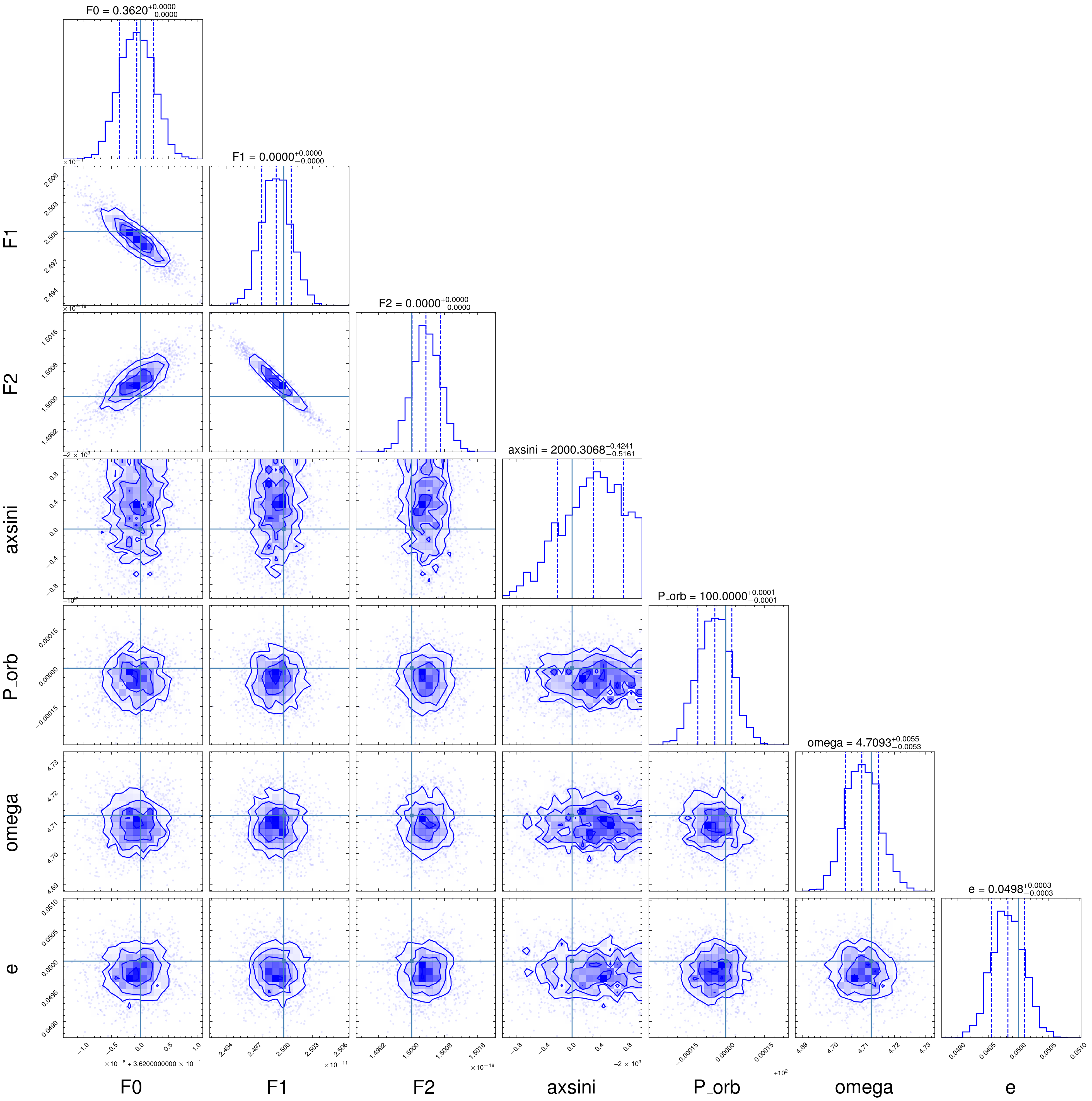[1]:
%pylab
%matplotlib inline
from astropy.io import fits
import glob
import wget
import warnings
warnings.filterwarnings('ignore')
plt.style.use(['science', 'nature'])
plt.rcParams['figure.dpi'] = 250
np.random.seed(20170615)
Using matplotlib backend: <object object at 0x7fe6cd4bc0a0>
Populating the interactive namespace from numpy and matplotlib
Binary System Analysis
Download Data
First, we use wget to download the data, taking the observation data for Cen X-3 from IXPE as an example. This data has several advantages: - The data size is manageable. - It’s real and publicly available.
The orbital parameter provided by the GBM epoch-folding monitor (https://gammaray.nsstc.nasa.gov/gbm/science/pulsars/lightcurves/cenx3.html)
RA |
170.3133 deg |
Decl |
-60.6233 deg |
Orbital Period |
2.0869953 days |
Period Deriv. |
-1.0150E-08 days/day |
T half pi |
2455073.68504 (JED) |
axsin(i) |
39.653 light-sec |
Long. of periastron |
0.00 deg |
Eccentricity |
0.0000 |
[2]:
# Download the Example Data of IXPE on Cen X-3
!wget -q -nH --no-check-certificate --cut-dirs=5 -r -l0 -c -N -np -R 'index*' -erobots=off --retr-symlinks \
https://heasarc.gsfc.nasa.gov/FTP/ixpe/data/obs/01//01006501/event_l2/
!wget -nH --no-check-certificate --cut-dirs=5 -r -l0 -c -N -np -R 'index*' -erobots=off --retr-symlinks \
https://heasarc.gsfc.nasa.gov/FTP/ixpe/data/obs/01/01006501/hk/ixpe01006501_all_orb_v07.fits.gz
--2023-06-20 11:45:07-- https://heasarc.gsfc.nasa.gov/FTP/ixpe/data/obs/01/01006501/hk/ixpe01006501_all_orb_v07.fits.gz
Resolving heasarc.gsfc.nasa.gov (heasarc.gsfc.nasa.gov)... 129.164.179.23
Connecting to heasarc.gsfc.nasa.gov (heasarc.gsfc.nasa.gov)|129.164.179.23|:443... connected.
HTTP request sent, awaiting response... 304 Not Modified
File ‘01006501/hk/ixpe01006501_all_orb_v07.fits.gz’ not modified on server. Omitting download.
[3]:
!ls 01006501/*
01006501/event_l2:
ixpe01006501_det1_evt2_v15.fits.gz ixpe01006501_det3_evt2_v15.fits.gz
ixpe01006501_det2_evt2_v15.fits.gz
01006501/hk:
ixpe01006501_all_orb_v07.fits.gz
Barycentric Correction
Next, we use the barycor function from the tatpulsar package to apply a barycentric correction based on the solar system’s center of mass. Please note that for IXPE data, HEAsoft has a dedicated correction program (barycorr). Here, we are demonstrate that tatpulsar package also includes a valid barycentric correction function.
[4]:
## READ Data
file = glob.glob("./01006501/event_l2/ixpe01006501_det*.fits.gz")
orbit = glob.glob("./01006501/hk/ixpe01006501_all_orb_v07.fits.gz")
time = np.array([])
for evt in file:
print(evt)
hdulist = fits.open(evt)
time = np.append(time, hdulist[1].data.field("TIME"))
./01006501/event_l2/ixpe01006501_det1_evt2_v15.fits.gz
./01006501/event_l2/ixpe01006501_det2_evt2_v15.fits.gz
./01006501/event_l2/ixpe01006501_det3_evt2_v15.fits.gz
[5]:
from tatpulsar.utils.functions import met2mjd, mjd2met
from tatpulsar.pulse.barycor.barycor import barycor
ra=170.313301
dec=-60.6233
tdb_mjd = barycor(met2mjd(time, telescope='ixpe'),
ra=ra, dec=dec,
orbit=orbit[0],
accelerate=True)
tdb_met = mjd2met(tdb_mjd, 'ixpe')
Accelerating barycor
Frequency Search without Binary correction
Next, we perform a period search for the pulsar using the epoch_folding_search function in stingray.
What we demonstrate here is that the period found before applying the binary orbit correction is not the intrinsic period of the neutron star. The actual period differs from the modulated period found, due to the binary orbit modulation.
However, once we apply the binary orbit correction to the photons, the period found is indeed the intrinsic period of the neutron star.
[6]:
from stingray.pulse.search import epoch_folding_search
period = 4.79660
nbin = 64
df_min = 1e-4
df = 1e-5
frequencies = np.arange(1/period - 1e-3, 1/period + 1e-3, df)
freq, efstat = epoch_folding_search(tdb_met, frequencies, nbin=nbin)
[7]:
plt.rcParams['figure.dpi'] = 250
plt.figure()
plt.plot(freq, efstat)
plt.axhline(nbin -1, ls='--', lw=3, color='k', label='n-1')
plt.axvline(1/period, lw=3, alpha=0.5, color='r', label='True frequency')
plt.axvline(freq[np.argmax(efstat)], lw=3, alpha=0.5, color='k', label='Observed frequency')
plt.xlabel("Freq (Hz)")
plt.ylabel("EF stat")
plt.legend()
[7]:
<matplotlib.legend.Legend at 0x7fe6b5c66ed0>
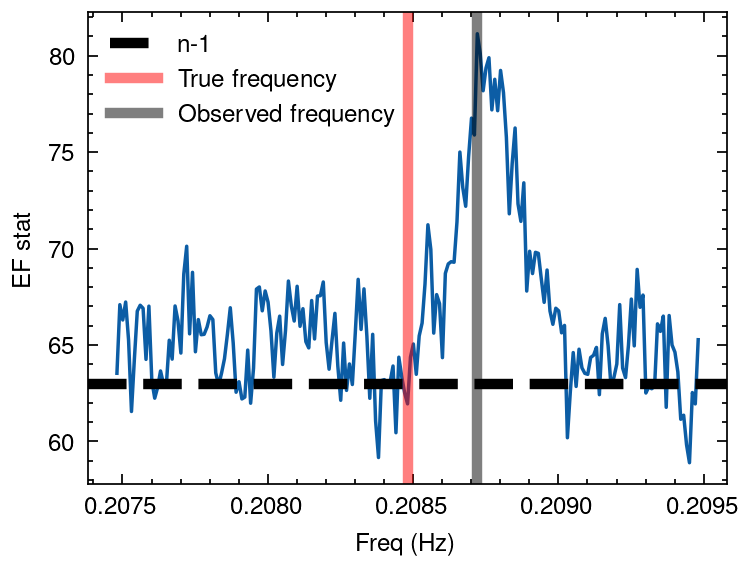
Binary Correction
Next, we apply a binary orbit correction using two methods. One is the correction under extreme gravitational fields as described in Deeter’s paper, and the other is by solving Kepler’s equation to calculate the intrinsic emission time of the photons in the binary system.
Deeter correction
Correct the photon arrival times to the photon emission time Deeter model.
Reference: Deeter et al. 1981, ApJ, 247:1003-1012
[8]:
from tatpulsar.pulse.binary import orbit_cor_deeter
#-----------------------------------
Porb = 2.0869953 #day
axsini = 39.653 #light-sec
e = 0.0000
omega = 0.00 - np.pi/2
T_pi2 = 2455073.68504 - 2400000.5 #mjd
x_mid = 298
y_mid = 306
Tnod = T_pi2 + Porb/2 # mjd
tnod = mjd2met(Tnod, telescope='ixpe') #met
tdb_bicor = orbit_cor_deeter(tdb_met, Porb*86400, axsini, e, omega, tnod)
## EF search
period = 4.79660
nbin = 16
df_min = 1e-4
df = 1e-6
frequencies = np.arange(1/period- 1e-3, 1/period + 1e-3, df)
freq, efstat = epoch_folding_search(tdb_bicor, frequencies, nbin=nbin)
# Plotting
plt.plot(freq, efstat)
plt.axhline(nbin -1, ls='--', lw=3, color='k', label='n-1')
plt.axvline(1/period, lw=3, alpha=0.5, color='black', label='True frequency')
plt.axvline(freq[np.argmax(efstat)], lw=3, alpha=0.5, color='r', label='Observed frequency')
plt.xlabel("Freq (Hz)")
plt.ylabel("EF stat")
plt.legend()
[8]:
<matplotlib.legend.Legend at 0x7fe6b73d4fd0>
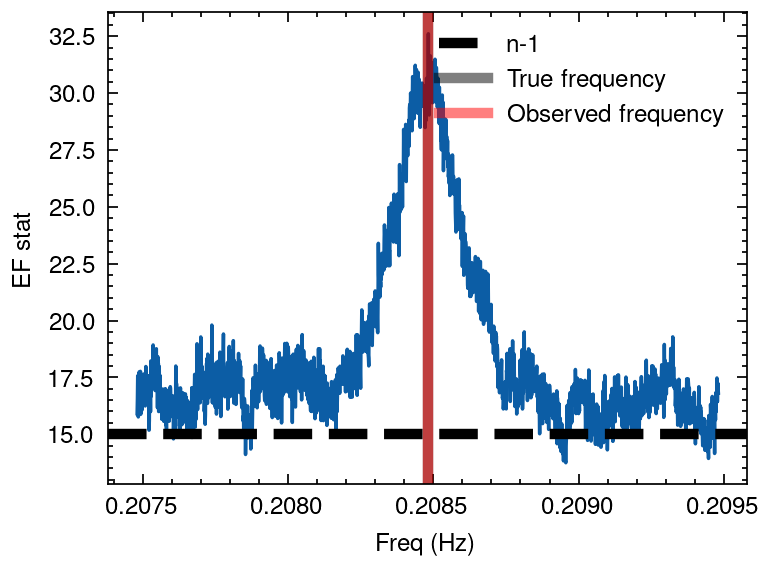
Solving Kepler equation
[9]:
from tatpulsar.pulse.binary import orbit_cor_kepler
[10]:
help(orbit_cor_kepler)
Help on function orbit_cor_kepler in module tatpulsar.pulse.binary:
orbit_cor_kepler(time, Tw, ecc, Porb, omega, axsini, PdotOrb=0, omegadot=0, gamma=0)
Corrects observed times of photons to their emission times
based on the Kepler function for a binary system.
Parameters
----------
time: float
The time of observed photon in MJD
Tw: float
The periastron time in MJD
ecc: float
Eccentricity
Porb: float
Orbital period in second
PdotOrb: float (optional)
Second derivative of Orbital period in sec/sec default is 0
omega: float
Long. of periastron in radians.
omegadot: float (optional)
second derivative of Long. of periastron in rad/sec
axsini: float
projection of semi major axis in light-sec
gamma: float
0
Returns
-------
t_em: float
The emitting time of photon in binary system in MJD
Example
-------
>>> observed_time = np.array([...]) # Time series in MJD
>>> Tw = 54424.71 #Barycentric time (in MJD(TDB)) of periastron
>>> e = 0.68 #orbital eccentricity
>>> Porb = 249.48 * 86400. #Orbital period (s)
>>> omega = -26. *np.pi/180. #Longitude of periastron (radians)
>>> axsin = 530. #Projected semi-major axis (light seconds)
>>> Porb_dot = 0 #First derivative of Orbital period
>>> binary_corrected_time = orbit_cor_kepler(observed_time
Tw=Tw,
ecc=e,
Porb=Porb,
Porb_dot,
omega,
0,
asin,
0)
[11]:
#-----------------------------------
Porb = 2.0869953 #day
axsini = 39.653 #light-sec
e = 0.0000
omega = 0.00 - np.pi/2
T_pi2 = 2455073.68504 - 2400000.5 #mjd
T_periastron = T_pi2 + Porb/2 # mjd
t_periastron = mjd2met(Tnod, telescope='ixpe') #met
tdb_bicor_kepler = orbit_cor_kepler(met2mjd(tdb_met, 'ixpe'),
Tw=T_periastron,
ecc=e,
Porb=Porb*86400,
omega=omega,
axsini=axsini)
tdb_bicor_kepler = mjd2met(tdb_bicor_kepler, 'ixpe')
[12]:
## EF search
period = 4.79660
nbin = 16
df_min = 1e-4
df = 1e-6
frequencies = np.arange(1/period- 1e-3, 1/period + 1e-3, df)
freq, efstat = epoch_folding_search(tdb_bicor_kepler, frequencies, nbin=nbin)
# Plotting
plt.plot(freq, efstat)
plt.axhline(nbin -1, ls='--', lw=3, color='k', label='n-1')
plt.axvline(1/period, lw=3, alpha=0.5, color='r', label='True frequency')
plt.axvline(freq[np.argmax(efstat)], lw=3, alpha=0.5, color='k', label='Observed frequency')
plt.xlabel("Freq (Hz)")
plt.ylabel("EF stat")
plt.legend()
[12]:
<matplotlib.legend.Legend at 0x7fe6b6eb00d0>
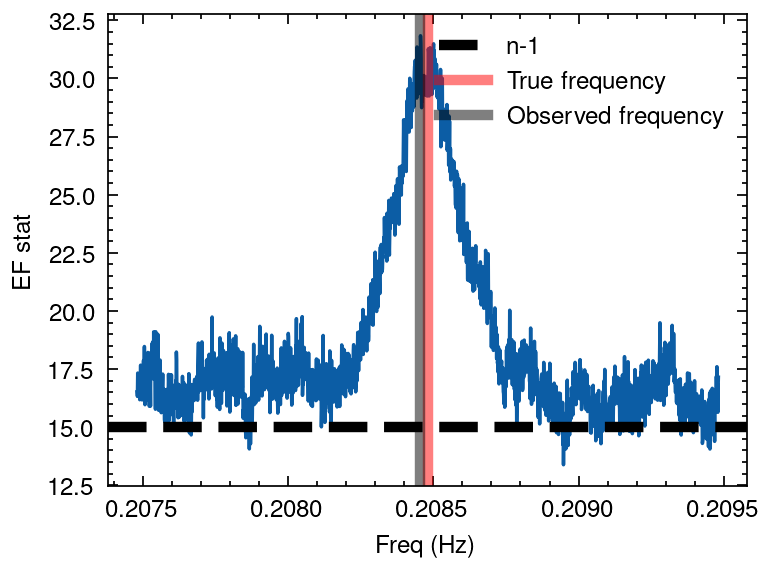
Determining Binary Ephemeris
For those binary systems with no known binary ephemeris, several strategies can be employed to uncover the binary characteristics of the system. In this section, we’ll explore these methods using data from the X-ray binary 4U 1901+03 as an illustrative example on how to derive the binary solution.
Simulate Binary modulation
[13]:
## Simulate the intrinsic frequency evolution of NS
mjd = np.linspace(58000, 59000, 100)
f0_fake = 0.362
f1_fake = 2.5e-11
f2_fake = 1.5e-18
dt = (mjd-mjd.min())*86400
freq_true = f0_fake + f1_fake*dt + (1/2)*f2_fake*dt**2
freq_err = np.ones(freq_true.size)*1e-6 # Hz/s
## Gaussian sampling from the Frequencies data set
freq = np.random.normal(loc=freq_true, scale=freq_err, size=freq_true.size)
plt.title("The Intrinsic Period of NS")
plt.errorbar(mjd, freq, yerr=freq_err, fmt='.', c='k')
plt.xlabel("Time (MJD)")
plt.ylabel("Frequency (Hz)");
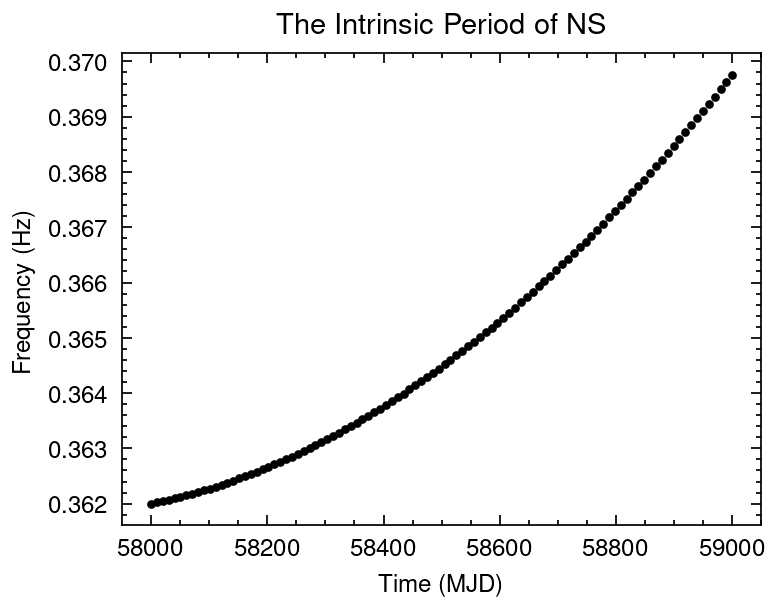
[14]:
def intrinsic_freq(t, f0, f1, f2):
t0 = t.min()
dt = (t - t0)*86400
f = f0 + f1*dt + 0.5*f2*(dt**2) #+ (1/6)*f3*(dt**3) + (1/24)*f4*(dt**4)
return f
from scipy.optimize import curve_fit
popt_infrq, pcov_infrq = curve_fit(intrinsic_freq,
mjd,
freq)
from matplotlib import gridspec
def plot_dataresi(x, y, yerr,
model,
xlabel="Time (MJD)",
ylabel="Freqency (Hz)",
legend="Model"):
fig, (ax1, ax2) = plt.subplots(2,1)
gs = gridspec.GridSpec(2,1, height_ratios=[2,1])
ax1 = plt.subplot(gs[0])
ax2 = plt.subplot(gs[1], sharex=ax1)
ax1.xaxis.set_ticks_position('none')
plt.setp(ax1.get_xticklabels(), visible=False)
ax1.errorbar(x, y, yerr=yerr, fmt='.', c='k')
ax1.errorbar(x, model, c='r', label=legend)
ax2.errorbar(x, (y-model)/freq_err,
yerr=1, fmt='.', c='k')
ax2.axhline(y=0, c='r')
ax2.set_xlabel("Time (MJD)")
ax1.set_ylabel("Frequency (Hz)")
ax2.set_ylabel("$\chi$")
ax1.legend()
plot_dataresi(mjd, freq, freq_err,
intrinsic_freq(mjd, *popt_infrq),
xlabel="Time (MJD)", ylabel="Freqency (Hz)")
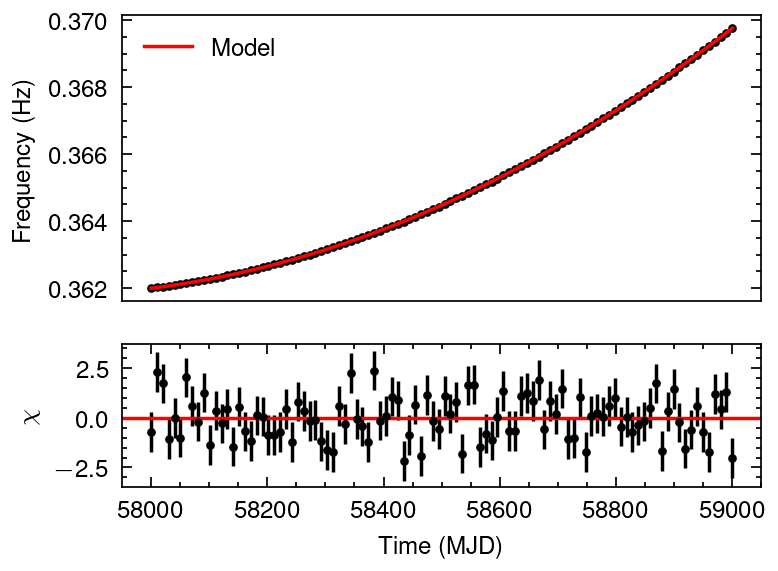
[15]:
from tatpulsar.pulse.binary import freq_doppler
fake_axsini = 2000
fake_Porb = 100 #days
fake_omega = 1.5*np.pi
fake_e = 0.05
fake_T_halfpi = 58540
print(f"The fake orbital parameters modulated on the intrinsic frequencies are:\n\n axsini={fake_axsini}\n Porb={fake_Porb} days\n omega={fake_omega}\n"+\
f" e={fake_e}\n T_halfpi={fake_T_halfpi}\n"+\
f" F0={f0_fake}, F1={f1_fake}, F2={f2_fake}")
f_dopp = freq_doppler(mjd2met(mjd, 'fermi'),
freq[0],
axsini=fake_axsini,
Porb=fake_Porb*86400,
omega=fake_omega,
e=fake_e,
T_halfpi=fake_T_halfpi)
freq_obs = f_dopp + freq
plot_dataresi(mjd, freq_obs, freq_err,
freq,
xlabel="Time (MJD)", ylabel="Freqency (Hz)", legend="NS intrinsic Frequency")
The fake orbital parameters modulated on the intrinsic frequencies are:
axsini=2000
Porb=100 days
omega=4.71238898038469
e=0.05
T_halfpi=58540
F0=0.362, F1=2.5e-11, F2=1.5e-18
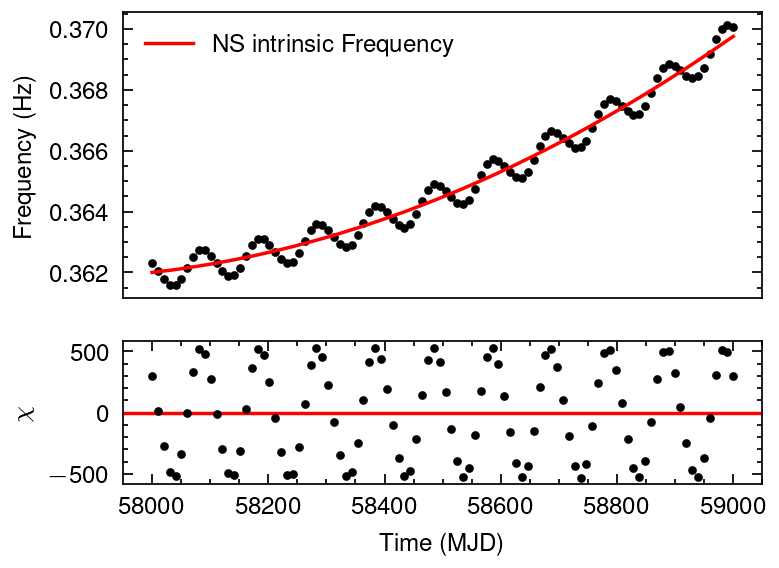
Least Square Fitting
[16]:
def wrapper_fun(t,
f0, f1, f2,
axsini, Porb, omega, e):
dt = t-t.min()
freq = f0 + f1*dt + (1/2)*f2*dt**2
return freq_doppler(t, freq[0], axsini, Porb*86400, omega, e, fake_T_halfpi) + freq
popt, pcov = curve_fit(wrapper_fun, mjd2met(mjd, 'fermi'), freq_obs,
p0=[f0_fake, f1_fake, f2_fake,
fake_axsini, fake_Porb, fake_omega, fake_e])
plt.errorbar(mjd, wrapper_fun(mjd2met(mjd, 'fermi'), *popt) - freq_obs,
yerr=freq_err, fmt='.', c='k')
plt.ylabel("$\chi$")
plt.xlabel("Time (MJD");
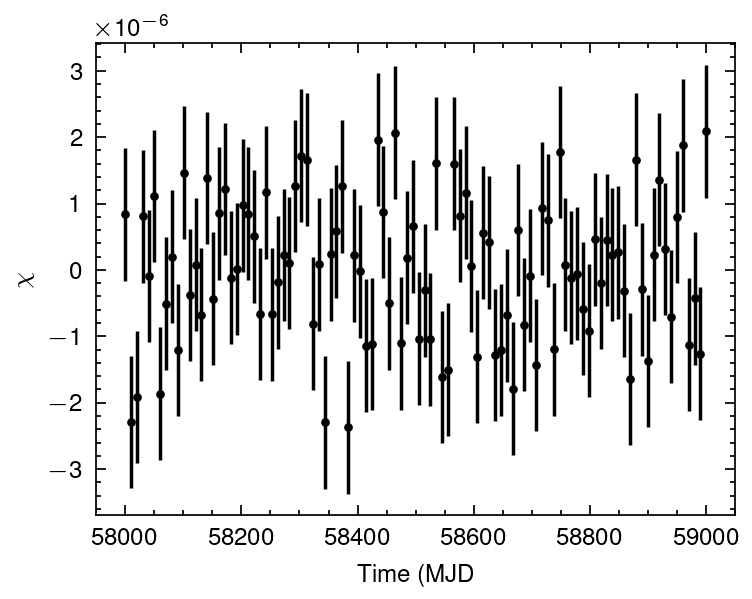
[17]:
def report_result(popt, pcov):
perr = np.sqrt(np.diag(pcov))
par_name = ['F0', 'F1', 'F2', 'axsini', 'Porb', 'Omega', 'Eccentricity']
for i in range(len(popt)):
print(f"{par_name[i]}: {popt[i]} +- {perr[i]}")
report_result(popt, pcov)
F0: 0.3619999406313884 +- 3.3209695685669207e-07
F1: 2.4992247763193333e-11 +- 1.775394439010689e-14
F2: 1.5003531933140412e-18 +- 3.9764514319685076e-22
axsini: 2000.395060610975 +- 0.6074379363926161
Porb: 99.99995771438674 +- 7.31267183081882e-05
Omega: 4.709537609067158 +- 0.006136431597904715
Eccentricity: 0.04981853019176014 +- 0.00030180024800663245
Bayesian Approach (emcee)
The logrithmic Likelihood function is:
$:nbsphinx-math:ln\mathcal{L}`(:nbsphinx-math:theta | :nbsphinx-math:mathcal{D}`) = -\frac{1}{2} \sum `:nbsphinx-math:frac{(f_{rm{obs}} - f_{rm{model}})^2}{sigma^2}` $
[18]:
parameters = ['F0', 'F1', 'F2', 'axsini', 'P_orb', 'omega', 'e']
# Expect values: axsini=2000
# Porb=100 days
# omega=4.71238898038469
# e=0.45
# T_halfpi=58540
# F0=0.362, F1=2.5e-11, F2=1.5e-18
t = mjd2met(mjd, 'fermi')
data = freq_obs
err = freq_err
def log_likelihood(params, x, y ,yerr):
f0, f1, f2, axsini, P_orb, omega, e = params
P_orb = P_orb * 86400
T_halfpi = mjd2met(58540, 'fermi')
t0 = x.min()
dt = x - t0
f_spin = f0 + f1*dt + 0.5*f2*dt**2
f_dopp = freq_doppler(x, f0, axsini, P_orb, omega, e, fake_T_halfpi)
model = f_spin + f_dopp
loglike = -0.5 * np.sum(((y - model)**2/(yerr**2)))
return loglike
def log_prior(params):
f0, f1, f2, axsini, P_orb, omega, e = params
if 0.2 < f0 < 0.563 and 1e-13 < f1 < 6e-11 and 1e-20 < f2 < 6e-18 and 1000 < axsini < 3000 and 50 < P_orb < 150 and np.pi < omega < 3*np.pi and 0 < e < 1:
return 0.0
return -np.inf
def log_probability(params, x, y, yerr):
lp = log_prior(params)
if not np.isfinite(lp):
return -np.inf
return lp + log_likelihood(params, x, y, yerr)
[19]:
from scipy.optimize import minimize
nll = lambda *args: -log_likelihood(*args)
initial = [f0_fake, f1_fake, f2_fake, fake_axsini, fake_Porb, fake_omega, fake_e]
soln = minimize(nll, initial, args=(t, data, err), method = 'Nelder-Mead')
nwalkers = 32
npars = len(initial)
pos = soln.x+ np.zeros((nwalkers, npars))
pos[:,0] = pos[:,0] + 1e-14 * np.random.randn(nwalkers)
pos[:,1] = pos[:,1] + 1e-14 * np.random.randn(nwalkers)
pos[:,2] = pos[:,2] + 1e-18 * np.random.randn(nwalkers)
pos[:,3] = pos[:,3] + 1e-6 * np.random.randn(nwalkers)
pos[:,4] = pos[:,4] + 1e-14 * np.random.randn(nwalkers)
pos[:,5] = pos[:,5] + 1e-14 * np.random.randn(nwalkers)
pos[:,6] = pos[:,6] + 1e-14 * np.random.randn(nwalkers)
# pos = soln.x + 1e-15 * np.random.randn(nwalkers, 7)
# print(pos[:,1])
nwalkers, ndim = pos.shape
[20]:
import emcee
sampler = emcee.EnsembleSampler(
nwalkers, ndim, log_probability, args=(t, data, err)
)
sampler.run_mcmc(pos, 5000, progress=True);
100%|█████████████████████████████████████████████████████████████████████| 5000/5000 [00:11<00:00, 417.70it/s]
[21]:
fig, axes = plt.subplots(7, figsize=(10,7), sharex=True)
samples = sampler.get_chain()
for i in range(ndim):
ax = axes[i]
ax.plot(samples[:, :, i], "k")
ax.set_xlim(0, len(samples))
ax.set_ylabel(parameters[i])
ax.yaxis.set_label_coords(-0.1, 0.5)
axes[-1].set_xlabel("step number");
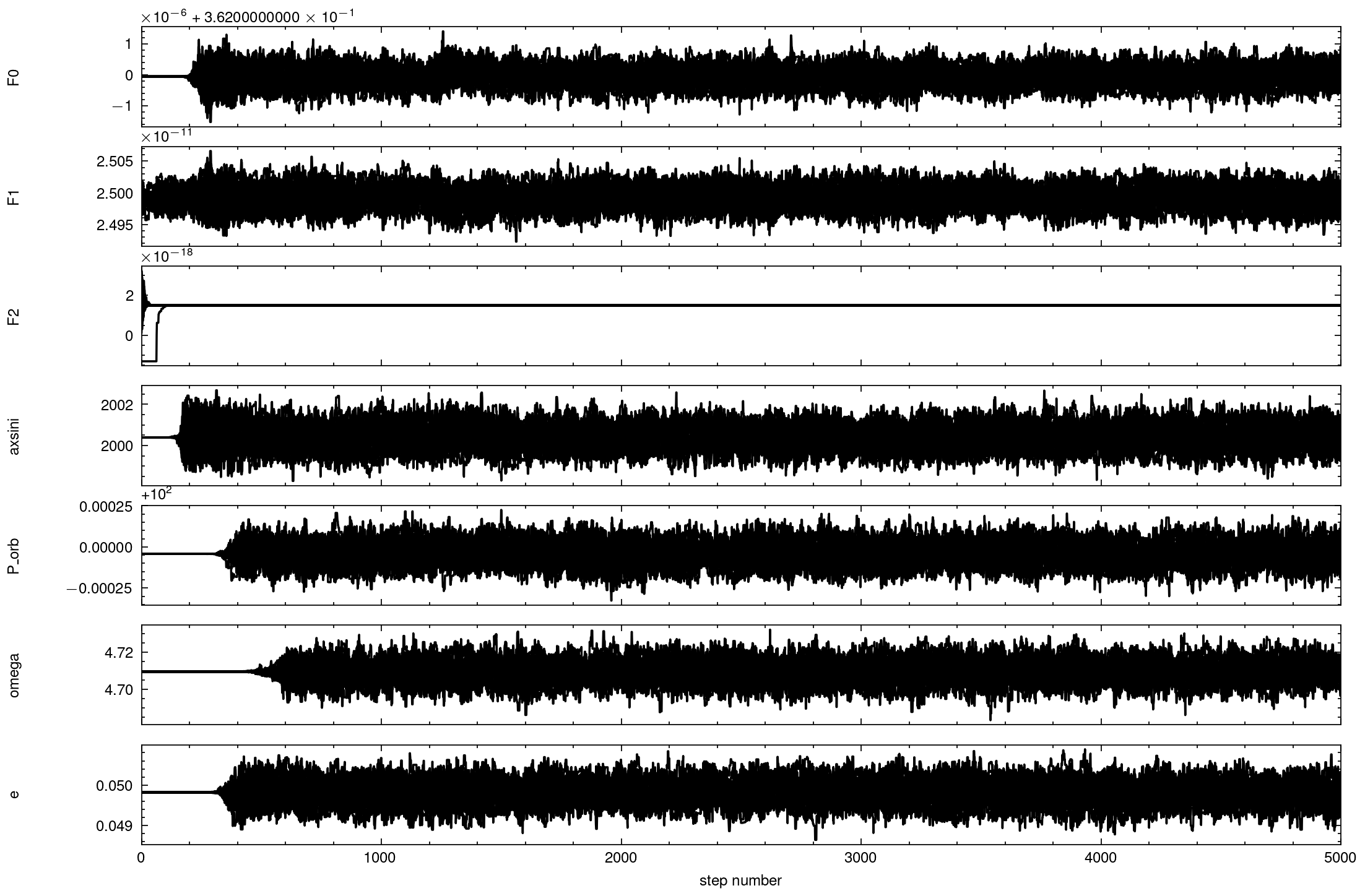
[22]:
import corner
flat_samples = sampler.get_chain(discard=3000, thin=15, flat=True)
fig = corner.corner(
flat_samples, labels=parameters, truths=[f0_fake, f1_fake, f2_fake, fake_axsini, fake_Porb, fake_omega, fake_e], color='b',
quantiles=[0.16, 0.5, 0.84], plot_datapoints=True,show_titles=True, title_kwargs={"fontsize": 12})
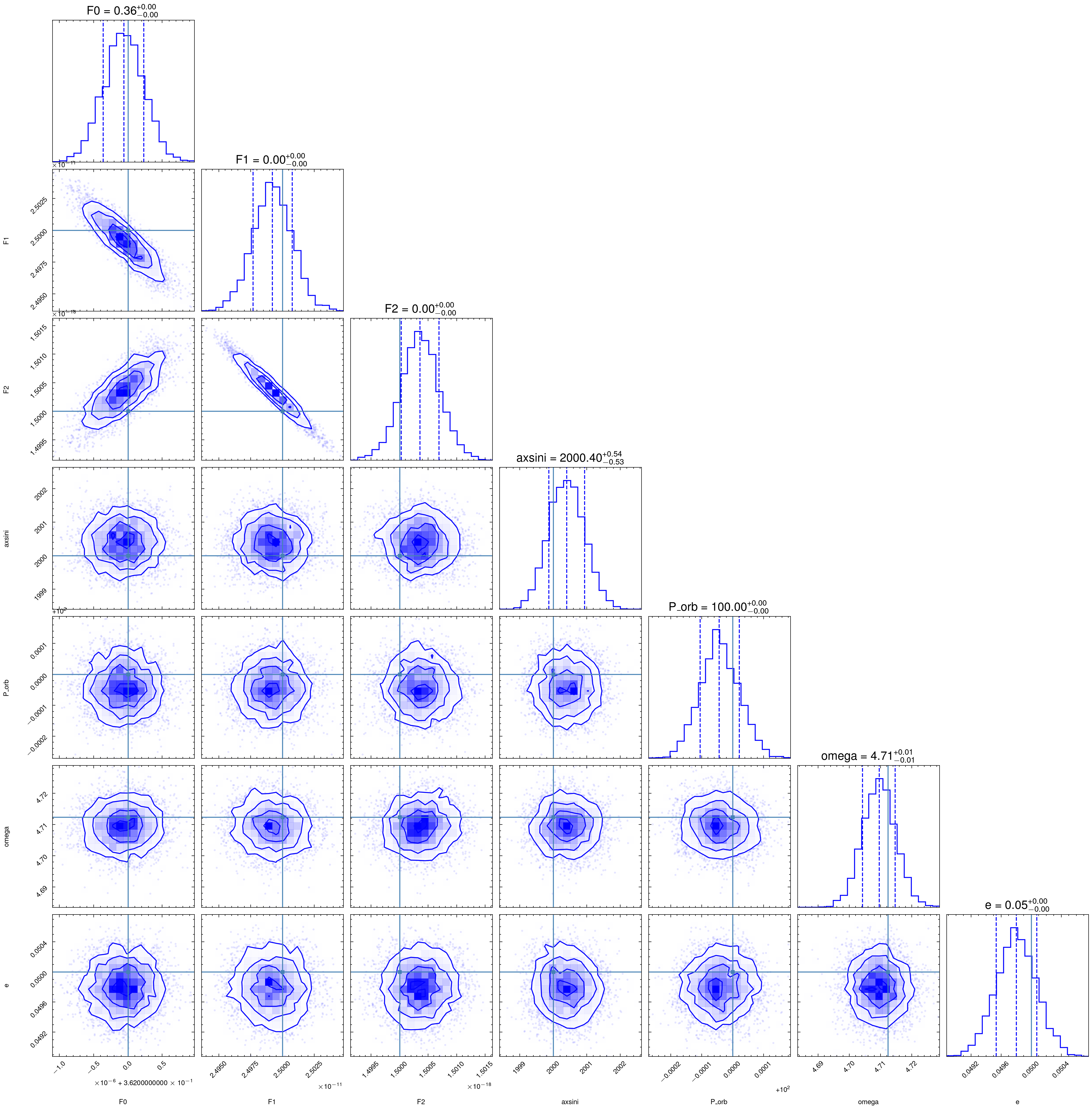
Bayesian Approach (Nested sampling)
[23]:
def log_likelihood_ns(params):
f0, f1, f2, axsini, P_orb, omega, e = params
P_orb = P_orb * 86400
T_halfpi = mjd2met(58540, 'fermi')
t0 = t.min()
f_spin = f0 + f1*(t-t0) + 0.5*f2*(t-t0)**2
f_dopp = freq_doppler(t, f0, axsini, P_orb, omega, e, fake_T_halfpi)
model = f_spin + f_dopp
loglike = -0.5* ((data - model)**2/err**2).sum()
return loglike
def prior_transform(cube):
# the argument, cube, consists of values from 0 to 1
# we have to convert them to physical scales
params = cube.copy()
params[0] = cube[0] * 0.02 + 0.361
params[1] = cube[1] * 5.0e-11 + 1.0e-11
params[2] = cube[2] * 5e-18 + 1e-18
# axsini
params[3] = cube[3] * 2 + 1999
# P_orb
params[4] = cube[4] * 2 + 99
#omega
params[5] = cube[5] * 2*np.pi + np.pi
# e
params[6] = cube[6]
return params
from ultranest import ReactiveNestedSampler
sampler = ReactiveNestedSampler(parameters, log_likelihood_ns, prior_transform,
wrapped_params=[False, False, False, False, False, False, False],
)
result = sampler.run(min_num_live_points=200, dKL=np.inf, min_ess=10)
[ultranest] Sampling 200 live points from prior ...
[ultranest] Explored until L=-6e+01 0 [-59.6800..-59.6798]*| it/evals=11223/136630 eff=8.2262% N=200 0 0 0 0 0
[ultranest] Likelihood function evaluations: 136950
[ultranest] logZ = -111.1 +- 0.3497
[ultranest] Effective samples strategy satisfied (ESS = 1291.4, need >10)
[ultranest] Posterior uncertainty strategy is satisfied (KL: 0.45+-0.09 nat, need <inf nat)
[ultranest] Evidency uncertainty strategy wants 214 minimum live points (dlogz from 0.28 to 0.94, need <0.5)
[ultranest] logZ error budget: single: 0.49 bs:0.35 tail:0.01 total:0.35 required:<0.50
[ultranest] Widening roots to 214 live points (have 200 already) ...
[ultranest] Sampling 14 live points from prior ...
Z=-111.1(98.93%) | Like=-59.68..-59.20 [-59.6797..-59.6784]*| it/evals=12003/149834 eff=6.0451% N=214 14 4 14 14 14
WARNING (pint.logging ): Sampling from region seems inefficient (0/40 accepted in iteration 2500). To improve efficiency, modify the transformation so that the current live points are ellipsoidal, or use a stepsampler, or set frac_remain to a lower number (e.g., 0.5) to terminate earlier.
[ultranest] Explored until L=-6e+01 0 [-59.6673..-59.6638]*| it/evals=12020/161385 eff=3.2554% N=214
[ultranest] Likelihood function evaluations: 161385
[ultranest] logZ = -111.1 +- 0.3096
[ultranest] Effective samples strategy satisfied (ESS = 1392.4, need >10)
[ultranest] Posterior uncertainty strategy is satisfied (KL: 0.46+-0.11 nat, need <inf nat)
[ultranest] Evidency uncertainty strategy wants 212 minimum live points (dlogz from 0.23 to 0.72, need <0.5)
[ultranest] logZ error budget: single: 0.48 bs:0.31 tail:0.01 total:0.31 required:<0.50
[ultranest] done iterating.
[24]:
import logging
import corner
def cornerplot(results, logger=None, **kwargs):
"""Make a corner plot with corner."""
paramnames = results['paramnames']
data = np.array(results['weighted_samples']['points'])
weights = np.array(results['weighted_samples']['weights'])
cumsumweights = np.cumsum(weights)
mask = cumsumweights > 1e-4
if mask.sum() == 1:
print(1)
if logger is not None:
print(2)
warn = 'Posterior is still concentrated in a single point:'
for i, p in enumerate(paramnames):
v = results['samples'][mask,i]
warn += "\n" + ' %-20s: %s' % (p, v)
logger.warning(warn)
logger.info('Try running longer.')
# return
# monkey patch to disable a useless warning
oldfunc = logging.warning
logging.warning = lambda *args, **kwargs: None
if 'truths' in kwargs:
truths=kwargs['truths']
else:
truths=None
corner.corner(data[mask,:], weights=weights[mask],
labels=paramnames, show_titles=True, quiet=True,
fontsize=20, title_fmt='.4f', title_kwargs={'fontsize':12},
label_kwargs={'fontsize':20},
quantiles=[0.16, 0.5, 0.84],
truths=truths,
color='b')
logging.warning = oldfunc
cornerplot(result, truths=[f0_fake, f1_fake, f2_fake, fake_axsini, fake_Porb, fake_omega, fake_e])
